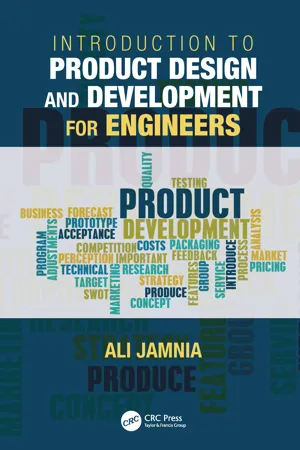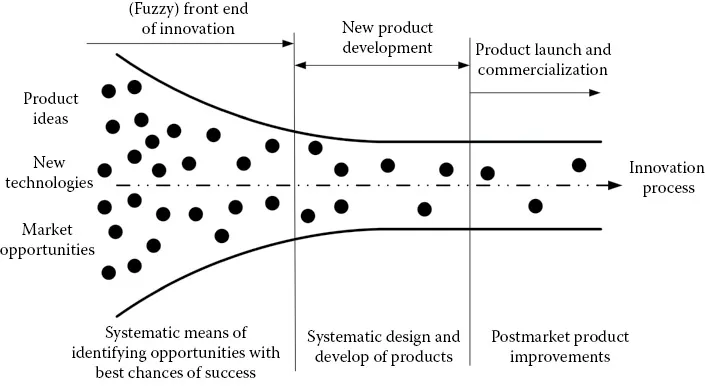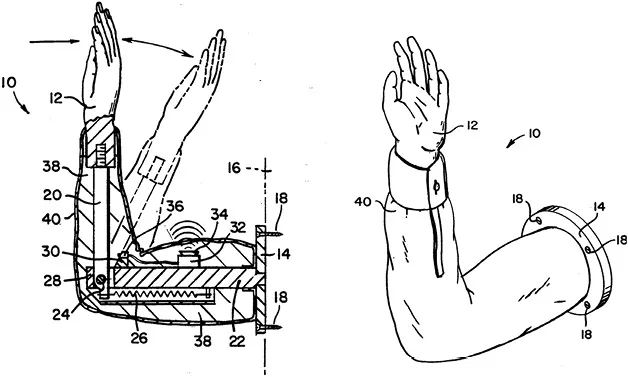
This is a test
- 423 pages
- English
- ePUB (mobile friendly)
- Available on iOS & Android
eBook - ePub
Introduction to Product Design and Development for Engineers
Book details
Book preview
Table of contents
Citations
About This Book
Introduction to Product Design and Development for Engineers provides guidelines and best practices for the design, development, and evaluation of engineered products. Created to serve fourth year undergraduate students in Engineering Design modules with a required project, the text covers the entire product design process and product life-cycle, from the initial concept to the design and development stages, and through to product testing, design documentation, manufacturability, marketing, and sustainability. Reflecting the author's long career as a design engineer, this text will also serve as a practical guide for students working on their capstone design projects.
Frequently asked questions
At the moment all of our mobile-responsive ePub books are available to download via the app. Most of our PDFs are also available to download and we're working on making the final remaining ones downloadable now. Learn more here.
Both plans give you full access to the library and all of Perlego’s features. The only differences are the price and subscription period: With the annual plan you’ll save around 30% compared to 12 months on the monthly plan.
We are an online textbook subscription service, where you can get access to an entire online library for less than the price of a single book per month. With over 1 million books across 1000+ topics, we’ve got you covered! Learn more here.
Look out for the read-aloud symbol on your next book to see if you can listen to it. The read-aloud tool reads text aloud for you, highlighting the text as it is being read. You can pause it, speed it up and slow it down. Learn more here.
Yes, you can access Introduction to Product Design and Development for Engineers by Dr. Ali Jamnia in PDF and/or ePUB format, as well as other popular books in Tecnología e ingeniería & Ingeniería civil. We have over one million books available in our catalogue for you to explore.
Information
1
Fuzzy Front End
Introduction
In the distant past—and particularly for technology companies—there was not a clear distinction between the time when engineers invented new technologies and when those technologies were incorporated into new products.* In that mindset, program and project managers would set schedules and communicate them to marketing people, who would then set customers’ (and to a large extent investors’) expectations of when a product would come to market. In those days, a clear definition or process for bringing innovation to market did not exist. Product launches were often delayed as a result of engineering and technical setbacks. Needless to say, delays of this nature eroded investors’ confidence in the company, which negatively impacted the level and degree of the organization’s investment in innovation. As time went by, the innovation process and product development were scientifically studied. This effort led to a number of theories being proposed and put into practice in order to bring efficiency and optimization to this practice.
Many of these theories identified three broad spectrums of the innovation process, beginning with the fuzzy front end of the process, followed by the new product development (NPD) step, and finally commercialization.
Within a corporate environment, when the decision to develop a product is made—that is, at the start of the NPD stage—windows of marketing opportunities are identified; timelines are set, schedules are developed; and product development activities begin in earnest. Due to both market and investor expectations, there is a rush to meet deadlines and timelines. There is little time to explore technology options or to examine “what-if” scenarios.
Explorations and what-if options belong to the fuzzy front end, when there are no set expectation and schedules. Should a corporation ignore the need for this exploration period, the rush to market may cause oversights and mistakes that may lead to program delays. The expression, “there is no time to do it right, but there is time to do it over,” might have its roots in this reality.
This chapter provides the reader with an understanding of the innovation process and its comparison and contrast with invention. To a large extent, the fuzzy front end is also a management process reflecting each organization’s way of filling their product pipeline. For further reading on this topic, I suggest works by Anthony (2012), Adner (2012), and Furr and Dyer (2014).
Innovation Process and Front End Funnel
Figure 1.1 depicts a typical innovation process funnel. In this model, a corporation invites its employees and stakeholders to provide ideas and suggestion for possible new products. At the same time, small technical teams are formed to either initiate development of new technologies or search for other technology start-up companies with promising concepts and even possibly working prototypes. In parallel, the corporation’s marketing team may be assessing and forecasting short-, mid-, and long-term market needs and trends.

Figure 1.1
A typical innovation process funnel.
At this front end, many proposed ideas may be tempting; however, a filtering system must be in place in order to align the proposed concepts with the organization’s technology roadmap and long-term strategies (Wheelwright and Clark 1992). These filters or “idea management processes” help identify both required technological and financial resources and estimate potential returns of investments. From these, a few concepts are selected for further development to reach a proof-of-concept phase. Needless to say, of the many proposals, only a few successfully complete the last stage and are placed in the new product development platform. Up until this point, there are no real deadlines for any given concepts—any one concept may be eliminated from the race at any time, and that process of elimination must actively filter the incoming and provide a few “nuggets” for further development. Once the surviving proposals are approved for development and commercialization, the organization’s mindset shifts into developing timelines and meeting milestones.
I have used “innovation” within the concept of the fuzzy front end. Often, innovation is used synonymously with “invention.” These terms represent slightly different concepts, and I would like to explore them next.
Innovation vs. Invention
Even though innovation and invention seem to be interrelated, they are quite distinct from one another. The basis of an invention—and therefore applying for its patent—is formed on the three legs of novelty, not being obvious (to someone skilled in the field), and, finally, being useful. Ironically, “useful” does not imply market success or financial rewards. The following expired patent entitled “Apparatus for Simulating a High-Five”—as shown in Figure 1.2—was granted in 1994. The inventors provided the following argument for the usability of this patent.
During a televised sporting event, a “high five” is commonly shared between fans to express the joy and excitement of a touchdown, home run, game-winning basket, birdie or other positive occurrence. Unfortunately, as known in the art, a “high five” requires the mutual hand slapping of two participants, wherein a first participant slaps an upraised hand against the elevated hand of a second participant. As such, a solitary fan is unable to perform a “high five” to express excitement during a televised sporting event.
Cohen
1994

Figure 1.2
A depiction of the patent “Apparatus for Simulating a High-Five”—United States Patent Number: 5,356,330, issued on October 18, 1994.
Even though one may argue in favor of the novelty and not-obvious aspect of this invention, it would be difficult to imagine that there is wide use for such a product.
In contrast, innovation is “A novel combination of art, science, or craft employed to create the goods or services used by society” (Quinn and Zien 1997, as quoted by Evans 2003). Kahn et al. (2005) define an innovation as, “A new idea, method or device. The act of creating a new product or process. The act includes invention as well as the work required to bring an idea or concept into final form.” One may also define innovation as developing fresh views of products, services, and/or processes with the idea of increasing efficiency and reducing waste.
Hence, one may conclude that invention is only an aspect of innovation. Although an invention is an innovation, an innovation may not need to involve any inventions at all.
Innovation Classifications
If inventions are a subset of innovation, one may ask what the other aspects of innovation are. Before answering this question, I would like to suggest that there are two aspects one needs to keep in mind. The first is the “what” of innovation, and the second is the “how.”* In this context, “how” is the organizational processes that would put filters in place to select and approve only the ideas that have the best chance of success. The “what” refers to different types of innovation. In this regard, Anthony (2012) suggests that innovation be viewed in one of two ways: the first being the str...
Table of contents
- Cover
- Half Title
- Title Page
- Copyright Page
- Dedication
- Contents
- Preface
- Acknowledgments
- Author
- 1. Fuzzy Front End
- Part I: Soft Skills of Engineering
- Part II: Front End-Product Development Life Cycle Management and Roadmap
- Part III: Requirements and Their Cascade
- Part IV: The Nuts and Bolts of the Design
- Part V: Preparation for Product Launch
- Part VI: Sustaining a Marketed Product
- Part VII: Engineering Skills Needed across All Disciplines
- References
- Glossary of Terms
- Index